Tiny but Vibrant: A Complete Guide to Caring for Chili Rasboras
They’re no bigger than a grain of rice, but Chili Rasboras light up an aquarium like sparks in the dark. With their fiery red hues and peaceful schooling behavior, these tiny fish bring an elegant vibrance to any nano tank. But don’t let their size fool you—keeping them healthy and thriving takes more than just dropping them into water and watching them swim.
Whether you’re building your first nano aquascape or looking to add a splash of refined color to your collection, this guide will walk you through everything you need to know—from tank setup and water parameters to feeding, behavior, and breeding—so your Chili Rasboras not only survive, but shine.
- Quick Care Stats
- Species Overview
- Appearance
- Tank Requirements
- Tank Setup
- Diet and Feeding
- Tank Mates
- Breeding
- Diseases & Treatment
- Frequently Asked Questions (FAQs)
Quick Care Stats
- Scientific Name: Boraras brigittae
- Common Name: Chili Rasbora, Mosquito Rasbora
- Origin: Borneo, Indonesia (peat swamps, blackwater streams)
- Max Length: 0.8 inches (2 cm)
- Minimum Tank: 5 gallons (19 liters)
- Stocking: 8–12 fish per 5 gallons; compatible with peaceful tankmates
- Temperament: Peaceful, shy, schooling
- Feeding: Omnivorous; micro-pellets, small flakes, live/frozen foods
- Breeding: Egg-layer; challenging due to small egg size
- Habitat: Blackwater streams, peat swamps with dense vegetation
- Tank Setup: Heavily planted, low flow, dark substrate
- Active Tank Levels: Middle to top
- Temperature: 74–82°F (23–28°C)
- pH: 4.0–7.0 (prefers acidic)
- Water Hardness: 1–10 dGH (soft water)
- Lifespan: 2–3 years
Species Overview
Chili Rasboras, scientifically known as Boraras brigittae, are tiny, vibrant freshwater fish endemic to the blackwater peat swamps and slow-moving streams of Borneo, Indonesia. These fish inhabit shallow, tea-colored waters stained by tannins from decomposing organic matter, such as fallen leaves and wood, in dense rainforest environments.
Their preferred habitats feature warm, soft, acidic waters with temperatures ranging from 24 to 28°C and a pH of 4.0 to 6.5, surrounded by thick aquatic vegetation and submerged roots. The slow currents and shaded conditions of these swamps provide an ideal setting for these diminutive fish, which rarely exceed 2 cm in length, to feed on tiny invertebrates, zooplankton, and organic particles while finding shelter from predators.
The vivid red-orange coloration of Chili Rasboras, accented by a bold black stripe and occasional iridescent spots, makes them a striking presence in their murky, plant-choked habitats. Their small size allows them to navigate effortlessly through dense vegetation, where they forage in the interstitial spaces between leaves and roots.
The blackwater environment, rich in microorganisms, supports their diet and provides a complex ecosystem where they can evade larger predators. However, their restricted range in Borneo’s peat swamps makes them highly vulnerable to habitat loss from deforestation, agricultural expansion, and palm oil plantations, which disrupt the delicate balance of these unique ecosystems.
A remarkable trait of Chili Rasboras is their schooling behavior, where they move in tight, synchronized groups, creating a dazzling visual effect as they dart through their environment. This behavior not only enhances their survival by confusing predators but also amplifies their vibrant colors, making them appear like a shimmering cloud in the water.
Their ability to thrive in low-oxygen, acidic conditions showcases their remarkable adaptability to the challenging blackwater habitats. Despite their small size, Chili Rasboras play a significant role in their ecosystem, contributing to the food web as both predators of tiny organisms and prey for larger species, highlighting their ecological importance in Borneo’s fragile wetlands.
Appearance
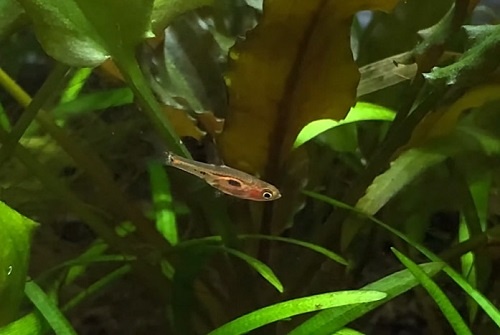
Chili Rasboras are renowned for their intense, fiery coloration, which makes them a standout in planted nano tanks. Key features include:
Base Color: A bright red-orange body with a distinct black horizontal stripe running from the snout to the tail, accented by a vivid red spot near the tail base. The coloration intensifies in healthy, stress-free fish.
Fins: Small, transparent fins with faint red or orange tints. The dorsal and anal fins are slightly rounded, contributing to their streamlined appearance.
Body Shape: Slender, elongated, and torpedo-like, their bodies are adapted for quick, darting movements through dense vegetation in their natural habitat.
Sexual Dimorphism: Males are brighter and slimmer, with more intense red-orange coloration and a sharper black stripe. Females are slightly duller and rounder, particularly when carrying eggs, with less pronounced markings.
Size: Reaching up to 0.8 inches (2 cm), their tiny size enhances their delicate, jewel-like presence in nano setups.
Additional Notes on Appearance
Their vibrant coloration is influenced by diet, water quality, and social dynamics. A nutrient-rich diet, acidic water, and a group of 8 or more enhance their fiery red-orange glow, while stress or poor conditions can cause fading. A dark substrate and subdued lighting amplify their colors, creating a stunning contrast in planted tanks.
Tank Requirements
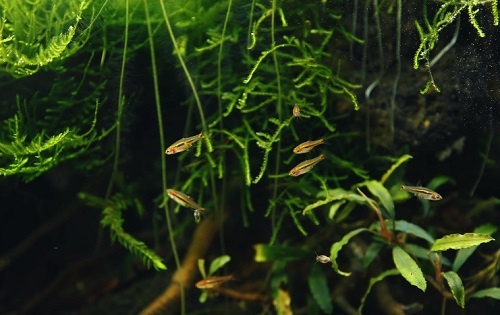
A minimum tank size of 5 gallons is suitable for a school of 8–12 Chili Rasboras, though a 10-gallon tank is ideal for greater stability and community setups. Stock conservatively at 2–3 fish per gallon, accounting for the bioload of tankmates. Maintain water parameters mimicking their blackwater habitat:
- Temperature: 74–82°F (23–28°C)
- pH: 4.0–7.0 (prefers acidic, 5.0–6.5 optimal)
- Hardness: 1–10 dGH
- Ammonia/Nitrite: 0 ppm
- Nitrate: <20 ppm
Their tendency to jump, especially when stressed or during feeding, requires a tight-fitting lid with no gaps. Chili Rasboras are highly sensitive to ammonia and nitrites, so a fully cycled tank with a reliable filtration system is essential. Weekly water testing with a high-quality test kit and 20–25% water changes using dechlorinated, pH-adjusted water maintain the pristine conditions they need to thrive.
Tank Setup
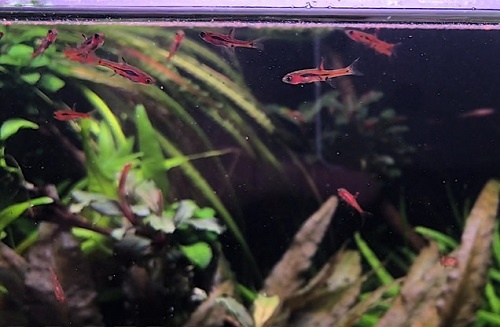
To replicate their blackwater peat swamp habitat, create a densely planted tank with a naturalistic, shaded environment. Use fine-leaved plants like Java moss, Cryptocoryne parva, or Bucephalandra for cover, paired with floating plants such as Salvinia or water lettuce to diffuse light and provide security. These plants also foster biofilm, a natural food source.
A dark substrate, such as fine gravel or black sand, enhances their red-orange coloration, creating a dramatic contrast. Add leaf litter (e.g., Indian almond leaves), driftwood, or smooth river rocks to release tannins, which lower pH and mimic their acidic, tannin-stained waters.
Use a gentle filtration system, such as a sponge filter or low-flow hang-on-back filter, to maintain calm water, as strong currents can stress these small fish. A reliable aquarium heater ensures stable temperatures, as fluctuations can lead to health issues. Subdued lighting, such as dimmable LED fixtures, suits their shy nature and prevents stress, while highlighting their colors against a dark substrate.
Additional Setup Considerations
- Tannins: Indian almond leaves or alder cones naturally lower pH and add beneficial tannins, enhancing their comfort and mimicking their habitat.
- Maintenance: Siphon uneaten food and debris weekly to prevent fouling, especially in nano tanks. Trim plants to maintain open swimming areas for their schooling behavior.
- Water Quality: Use RO/DI water or dechlorinated tap water adjusted with a pH-lowering additive (e.g., Seachem Acid Buffer) to achieve their preferred acidic conditions.
Diet and Feeding
Chili Rasboras are omnivorous, with a natural diet of zooplankton, small insects, and biofilm. Their tiny mouths require small, appropriately sized foods. Recommended foods include:
- Dry Foods: High-quality micro-pellets, crushed flakes, or powdered foods designed for nano fish (e.g., Hikari Micro Pellets, Fluval Bug Bites). These provide a balanced staple diet.
- Live/Frozen Foods: Supplement with live or frozen foods like baby brine shrimp, daphnia, micro-worms, or copepod nauplii to boost color, health, and natural foraging behavior.
- Vegetable Matter: They graze on algae and biofilm in the tank. Offer spirulina-based flakes or blanched greens (e.g., spinach, zucchini) sparingly to mimic this behavior.
- Feeding Frequency: Feed small portions 1–2 times daily, ensuring food is consumed within 1–2 minutes to prevent water fouling. Split feedings (morning and evening) help maintain consistent nutrition.
Feeding Tips
- Scatter food across the tank to ensure shy individuals eat, as dominant fish may monopolize food in small groups.
- Vary the diet weekly to prevent nutritional deficiencies and enhance their fiery coloration. Live foods are particularly effective for boosting vibrancy.
- Remove uneaten food promptly, especially in acidic water, where waste can rapidly degrade water quality.
A diverse diet supports their health, strengthens immunity, and maximizes their red-orange glow.
Tank Mates
Behavior and Temperament
Chili Rasboras are peaceful, shy, and thrive in schools of 8 or more, where they exhibit confident schooling behavior and vibrant colors. Smaller groups may lead to stress or reclusive behavior. They are non-aggressive but easily intimidated by larger, faster, or bolder tankmates, making them vulnerable to competition for food or predation. Their active, darting movements add liveliness to planted tanks, but they require a calm environment to flourish.
Suitable Tankmates
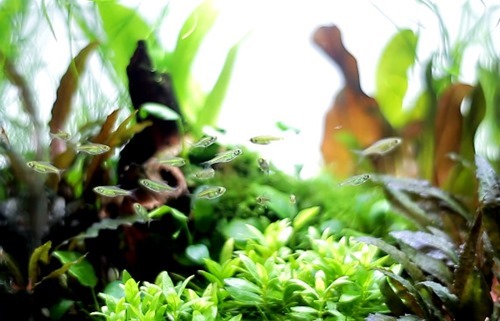
Kubotai rasbora
Choose tiny, peaceful species that share similar water requirements and do not outcompete or prey on Chili Rasboras. Ideal tankmates include:
Fish: Small species like ember tetras, celestial pearl danios, Pygmy corydoras (Corydoras pygmaeus), or Kuhli loaches. These occupy different tank levels and have minimal dietary overlap. In a community type of setup, peaceful tankmates such as kubotai rasbora, celestial pearl danios, sundadanios, otos, pygmy cories, and espei rasboras, make suitable tankmates.
Invertebrates: Dwarf shrimp, such as cherry shrimp or crystal red shrimp, are compatible, especially in densely planted tanks where shrimp can hide. Nerite or horned nerite snails are excellent for algae control and pose no threat.
Avoid: Larger or aggressive fish like bettas, gouramis, or cichlids, which may harass or eat rasboras. Avoid fin-nippers like tiger barbs or fast-moving species that dominate food resources.
Tankmate Considerations
Introduce rasboras to an established tank with tankmates already settled to reduce stress. Dense plants provide refuge during acclimation.
Monitor feeding to ensure rasboras get enough food, as their small size and shy nature make them poor competitors.
Ensure the tank is large enough (10+ gallons for community setups) to prevent overcrowding, which can increase stress and degrade water quality.
Breeding
Preparation for Breeding
Chili Rasboras are egg-scatterers that breed readily in captivity with proper conditions. Set up a dedicated 5–10-gallon breeding tank with fine-leaved plants (e.g., Java moss, Cabomba) or spawning mops to serve as egg deposition sites. Maintain acidic, stable water parameters to encourage spawning:
- Temperature: 76–80°F (24–27°C)
- pH: 5.0–6.5
- Hardness: 1–8 dGH
- Water Quality: Ammonia and nitrite at 0 ppm, nitrates below 15 ppm.
Condition a group of 3–4 males and 4–5 females for 1–2 weeks with high-protein live foods like micro-worms, baby brine shrimp, or daphnia to enhance fertility and health. Use a gentle sponge filter to maintain water quality without disturbing eggs or fry, and ensure a secure lid to prevent jumping. Dim lighting and dense plant cover reduce stress during spawning.
Breeding Process
Males court females with rapid chases and vibrant color displays, often darting through plants. Females scatter small batches of 10–30 adhesive eggs among fine-leaved plants or spawning mops, which males fertilize during spawning runs. Spawning occurs over several days, with eggs adhering securely to surfaces. Adults may eat eggs or fry, so remove them to the main tank post-spawning, or carefully transfer egg-laden plants/mops to a separate hatching tank with identical water parameters. Eggs hatch in 3–5 days at 78°F (26°C), depending on temperature.
Caring for Fry
Fry are extremely tiny and delicate, requiring specialized care to survive:
Initial Feeding: For the first 5–7 days, feed infusoria, paramecium, or commercial liquid/powdered fry food designed for small egg-layers. After 7–10 days, transition to newly hatched baby brine shrimp or micro-worms as they grow.
Nursery Tank: Use a 2–5-gallon bare-bottom tank with gentle aeration and fine-leaved plants or spawning mops for cover. Maintain identical water parameters to the breeding tank, performing 10% daily water changes with aged, temperature-matched, dechlorinated water.
Growth and Development: Fry grow slowly, reaching about 0.3 inches (0.8 cm) in 6–8 weeks. Gradually introduce finely crushed micro-pellets alongside live foods. Monitor for cannibalism and separate larger fry if necessary.
Fry are highly sensitive to pollutants, so meticulous water quality management is critical for survival.
Diseases & Treatment
Chili Rasboras are hardy but vulnerable to diseases if water quality deteriorates, particularly in their preferred acidic conditions. Common health issues and treatments include:
Ich (White Spot Disease): White spots on the body or fins, scratching, or lethargy indicate ich. Treat by gradually raising the tank temperature to 80–82°F (27–28°C) for 3–5 days and adding aquarium salt (1 teaspoon per gallon, pre-dissolved) or a commercial ich medication (e.g., API Super Ick Cure), following instructions. Increase aeration during treatment and perform 20% water changes before and after to maintain water quality.
Fungal Infections: Cotton-like patches on the body or fins suggest fungal issues, often linked to poor water quality or injury. Treat with antifungal medications like API Pimafix or methylene blue, following dosage instructions. Improve water quality with 20–25% water changes and ensure ammonia/nitrite levels are 0 ppm.
Stress: Faded colors, hiding, or reduced activity indicate stress, often caused by poor water quality, insufficient schooling size, or aggressive tankmates. Test and stabilize water parameters, ensure a school of 8 or more, and provide ample plant cover. Remove aggressive tankmates if necessary.
Fin Rot: Tattered or discolored fins suggest bacterial infection, typically linked to poor water quality. Treat with antibiotics like API Furan-2 or Seachem Kanaplex in a quarantine tank, following instructions. Perform 20–25% water changes and address root causes like inadequate filtration.
Prevention
Prevent health issues with proactive care:
- Perform weekly 20–25% water changes using dechlorinated, pH-adjusted water to maintain pristine conditions, especially in acidic setups.
- Test water parameters regularly with a reliable test kit to ensure stability, particularly ammonia, nitrite, and pH.
- Clean filters monthly to maintain efficient filtration without disrupting beneficial bacteria.
- Quarantine new fish, plants, or invertebrates for 2–4 weeks to prevent introducing pathogens.
- Maintain a school of 8 or more to reduce stress and promote natural behavior.
Daily observation of behavior and appearance allows early detection and treatment, ensuring vibrant, healthy rasboras.
Frequently Asked Questions (FAQs)
Q: Can Chili Rasboras live in a community tank?
A: Yes, they thrive with small, peaceful tankmates in a planted tank, but avoid aggressive or larger fish that may intimidate or prey on them.
Q: Do they need acidic water?
A: They thrive in acidic water (pH 4.0–7.0, ideally 5.0–6.5) but can adapt to neutral pH if conditions are stable and water quality is pristine.
Q: Are Chili Rasboras suitable for beginners?
A: Yes, they are suitable for beginners who can maintain stable water quality, provide a proper diet, and house them in a school of 8 or more.
Q: How many Chili Rasboras should I keep?
A: A school of 8–12 ensures social behavior, reduces stress, and enhances their fiery red-orange coloration, making the tank more visually appealing.
Q: Can they live in unheated tanks?
A: In tropical climates with stable room temperatures (75–80°F), a heater may not be needed, but in cooler regions, a heater is critical to maintain 74–82°F (23–28°C).
Q: How do I enhance their colors?
A: A varied diet with micro-pellets, live foods, and plant matter, combined with a dark substrate, tannins, and subdued lighting, maximizes their vibrant red-orange hue.
Q: How often do Chili Rasboras breed?
A: In optimal conditions with acidic water and abundant live food, they can spawn small batches of eggs every few days, making them prolific but challenging to rear due to fry size.

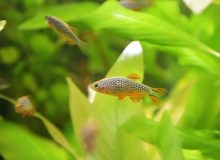
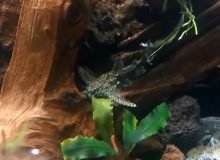
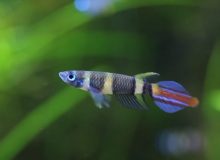
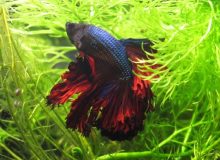
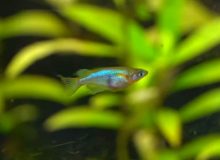
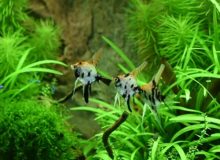
Leave a Reply